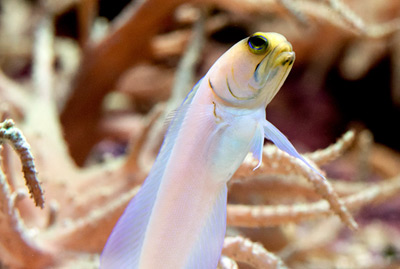When trying to determine whether different species of marine fish will cohabit peacefully in the same aquarium, we usually ask ourselves whether the combination will result in one fish eating another or whether interspecific squabbling is likely to be an issue based on disparate levels of territorial aggression. If we can answer “no” to each of those questions, we may be inclined to assume the species in question are, indeed, compatible.
In many cases that may be a safe conclusion to reach, but it overlooks another important (albeit more subtle) aspect of fish compatibility that is often underemphasized if not outright ignored—the natural differences in energy level that exist among various species.
What do I mean by this?
I’m referring to combining a shy and retiring species with a more boisterous and gregarious one. In this situation, the latter takes no interest whatsoever in the former from the standpoint of predation or territorial rivalry. In fact, it may not even acknowledge the shyer tankmate’s presence. Nonetheless, the combination can be a bad one, particularly with respect to the laid-back specimen.
From a human perspective, think of this in terms of forcing an introverted person to spend an entire day in a small room with an extrovert. The extrovert may be very kind, thoughtful, and pleasant, but by the end of that day, the introvert is going to need some serious alone time to decompress from the experience. It all comes down to different energy levels.
A shy jawfish
From a piscine perspective, I’m reminded of the time I kept a yellowhead jawfish (Opistognathus aurifrons) in the same tank with some tangs and planktivorous triggers. Technically, all these species were compatible. I never saw the tangs or triggers give the jawfish more than a passing glance. They spent most of their time swooping around the upper reaches of the tank while the jawfish mostly stayed in its burrow with only the top of its head showing.
Now, that last point should have told me something! When yellowhead jaws are at peace with the world, they tend to emerge completely (or almost completely) from their burrows and hover just above them. It’s stressed ones that stay mostly concealed. And when you think about it, it’s obvious why my specimen was hiding. When you’re a jawfish, danger generally comes from above, so all that hyperactivity going on overhead was just too unsettling—despite the fact that the tangs and triggers were completely minding their own business.
You may see similar stressed behavior in other timid fishes, such as comets (Calloplesiops spp.), dartfishes and firefishes (e.g., Ptereleotris and Nemateleotris spp.), mandarins (Synchiropus spp.), and others when they’re combined with more energetic species.
Why does it matter?
Okay, so passive fish are uncomfortable around energetic ones. Why does that matter? Actually, this is important for several reasons:
- One of the biggest issues becomes apparent during feedings. Assertive species easily outcompete more passive ones at mealtimes. In fact, some shy species may not feel confident enough to even come out of hiding and compete for their share. As a result, the shy fish may end up starving to death.
- Highly energetic fish keep timid species in a constant state of stress, which can eventually wear down their immune system and lead to illness.
- Constantly stressed fish are nervous and edgy, which means they’re more likely to jump from an aquarium at the slightest provocation to a dusty demise on the fish room floor.
Once you’re aware of this potential compatibility problem, avoiding it is fairly simple: When researching the temperament of any fish you’d like to keep, look for adjectives such as “shy,” “retiring,” “nervous,” “skittish,” “passive,” and the like. Then, if you decide to go ahead and purchase the fish, be sure to house it only with species of similar comportment.



